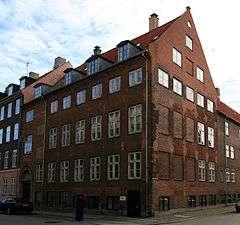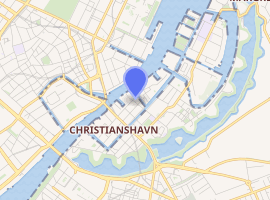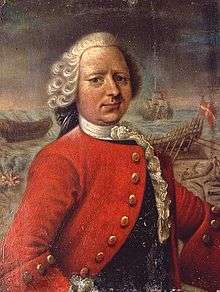Andreas Bjørn House
The Andreas Bjørn House is a historic property located at the corner of Strandgade (No. 46) and Bådsmandsstræde in the Christianshavn neighbourhood of Copenhagen, Denmark. It was built for Andreas Bjørn in 1734 and listed on the Danish registry of protected buildings and places in 1918. A sugar refinery named Union House was from 1771 to 1811 located in a now demolished warehouse adjacent to the building by a group of British merchants and plantation owners from St. Croix in the Danish West Indies.
| Jacob Holm House | |
|---|---|
 The Andreas Bjørn House | |

| |
| General information | |
| Location | Copenhagen, Denmark |
| Coordinates | 55°40′31.05″N 12°35′31.75″E |
| Inaugurated | 1734 |
Architecture
Andreas Bjørn and his dockyard

Bådsmandsstræde was the northernmost street in Johan Semp's original masterplan for Christianshavn from 1617. The narrow tract of land on the north side of Bådsmandsstræde was in the beginning of the 18th century the site of a lumberyard owned by Niels Alsing. It reached all the way from Strandgade to Christianshavn Canal and was partly lined with a row of wooden warehouses along the street. The property was in 1732 acquired by Andreas Bjørn. He demolished most of the buildings and constructed the Andreas Bjørn House at the corner of Strandgade and Bådsmandsstræde in 1834. He was also granted permission to establish a dockyard on reclaimed land to the north of his new property. Separated from the rest of Christianshavn by a branch of Christianshavn Canal (now Wilders Kanal), his dockyard became known as Bjørnsholm (Bjørn's Isle).[1]
Andreas Bjørn died in 1750 and his widow died in 1758. Their daughter, Karen Bjørn (1742-1795), who then inherited the property, married the writer and philosopher Thyge Rothe (1731-1795) in 1761. They purchased Tybjerggaard in 1763.
British owners andUnion House
In 1766 the property was purchased by William Chippendale (1747-1802). Originally from England, he had settled as a merchant in Copenhagen in 1760. He instantly sold part of the garden (closest to Christianshavn Caal) to ship builder Ole Gad.[2]
Chippendale's company traded on the Danish West Indies with its own fleet of merchant ships. Chippendale developed a good relationship to a number of Irish and English plantation owners on St. Croix. One of them, Nicolas Tuite, made a significant investment in his company. Robert Tuite and Charles August Selby, his son and nephew, were in return secured positions in the enterprise.[3] Selby established his own trading house after a couple of years.
In 1771, Chippendale, Selby, Tuite and two more investors from St. Croix established a sugar refinery in the warehouse located adjacent to Chippendale's House in Strandgade. The two new partners were Theobald Bourke and Christopher MacEvoy Sr.. The name of the sugar refinery was Union House.
In 1777, Robert Tuite became the sole owner of the house and sugar refinery in Strandgade. This happened on the same day that he purchased the Prince William Mansion on Sankt Annæ Plads]] in the fashionable Frederiksstaden. In 1779, he sold the Strandgade property bavk to Chippendale, Selbye and John Duncan. John Duncan and John Good, a merchant based in Helsingør, were the owners in 1784. Hohn Good and Charles Selbye owned it from 1792 and John Good owned it alone from 1802.
Laster history
The sugar refinery closed in 18011. Count Knud Bille Schack and Lauritz Berth purchased the building in 1812.
Architecture
See also
References
- "Sag: Andreas Bjørns Gård". Kulturstyrelsen (in Danish). Retrieved 1 May 2018.
- "Folkene bag sukkerraffinaderiet "Union House" 1771-1811 på Christianshavn". idahaugsted.dk (in Danish). Retrieved 1 May 2018.
- "Briterne". sortefortid.dk (in Danish). Retrieved 1 May 2018.
External links
- Niels Brocks Gård at indenforvoldene.dk
- Source